
If you are looking to optimize your Google Ads campaigns and get better results for your business, there is a special feature called Google Ads Experiments. These experiments allow you to test and fine-tune various campaign settings, giving you insights into what works best for your audience and goals.
In this guide, we’ll explore everything you need to know about Google Ads testing, including what it is, how to set it up, and best practices for running successful experiments.
Want to brainstorm with our team on new ways to scale your business with YouTube Ads (and other performance video platforms)?
Join us for a free YouTube ad brainstorming session👇
What are Google Ads experiments?
Google Ads experiments are a powerful feature provided by Google Ads. It allows you to carry out experimental campaigns for the purpose of A/B testing different campaign settings, such as targeting, ad copy, bidding strategies, and more.
One of the benefits of Experiments is that you don’t risk anything. You can experiment with different changes in your campaigns without fully implementing them and avoid making mistakes that could negatively impact your existing campaign’s performance.
To create an experiment, simply navigate to the Experiments tab located on the left-hand side of your Google Ads account dashboard.
By allocating an equal portion of the budget between the original campaign and the experiment, you can effortlessly compare the outcomes within a defined timeframe.
In case the experiment generates better outcomes, you can either apply the experiment to the original campaign or replace the original campaign entirely.
Benefits of Google Ads testing and experimenting
Most of the changes that advertisers make to their Google Ads campaigns are small, such as modifying the maximum cost-per-click or adding a new keyword to an ad group. These adjustments typically have minimal effects, and if something goes wrong, it can be easily fixed.
On the other hand, there are certain changes that can be a bit more risky, such as shifting a successful campaign from enhanced CPC (cost-per-click) to target CPA bidding. Such significant modifications can cause considerable fluctuations in both clicks and sales. This is where Google Ads Experiments can prove beneficial, as it enables advertisers to minimize risk by conducting an alternative version of a campaign on a smaller portion of traffic before implementing it fully.
6 Google Ads experiments you can run
Here are 6 Google Ads experiments you can run:
1. Performance Max experiment
2. Demand Gen experiment
3. Video experiment
4. App Uplift experiment
5. Optimise text ads
6. Custom experiment

1. Performance Max experiment
You can choose one of two experiments:
a) Test uplift of Performance Max
b) Test vs Standard Shopping campaign

a) Test uplift of Performance Max experiment
This first type of pMax experiment measures the impact of what happens if you add a Performance Max campaign to your account.
The first step is to select or create a new Performance Max campaign:
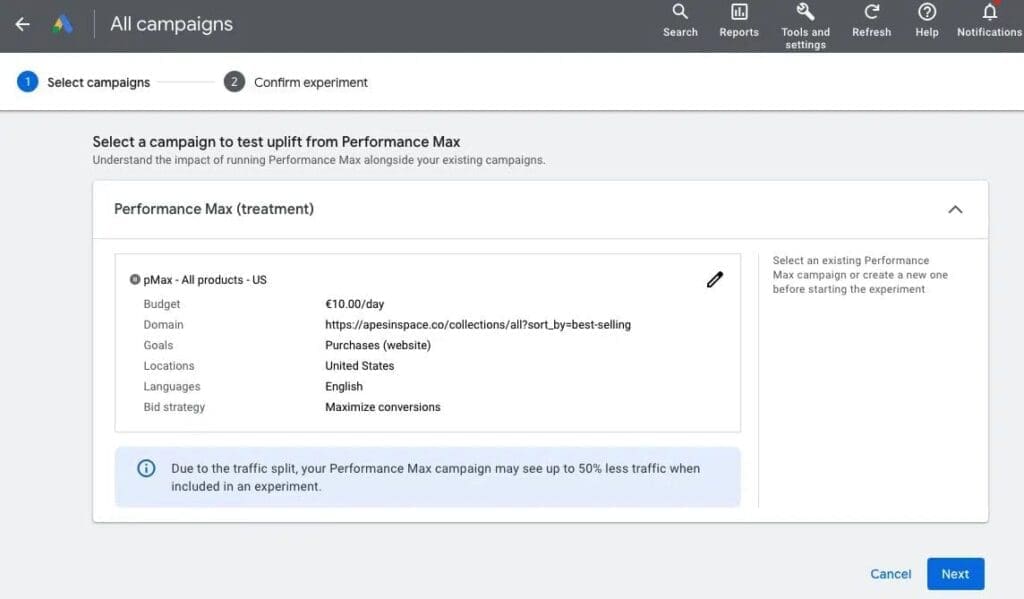
In the next step, you see that this setup will 50-50 test the traffic:
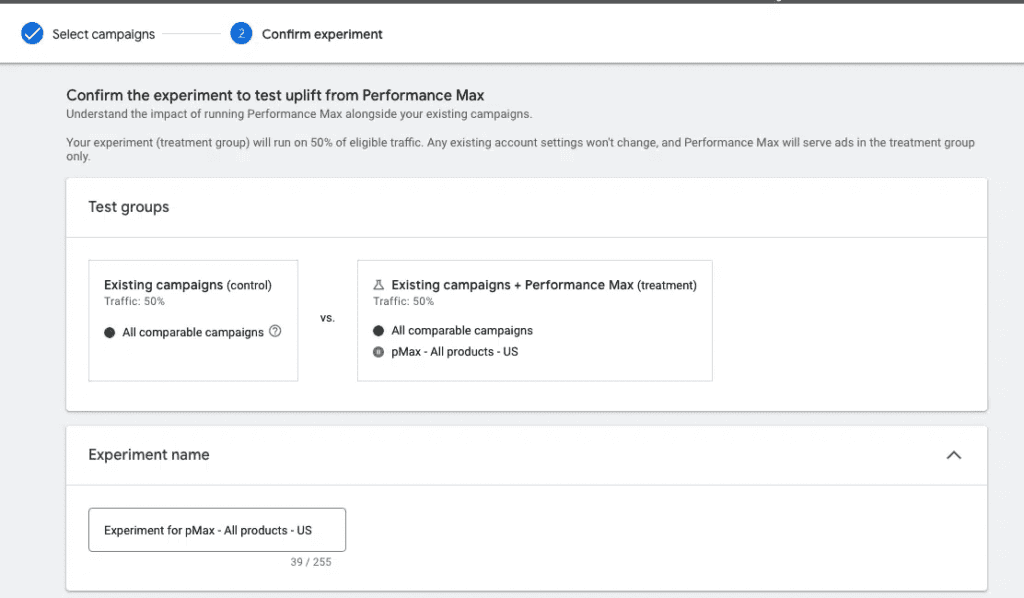
All you can do is set the start date for the experiment and that’s it.
Half of your traffic will go to your existing campaigns, while the other half will have your existing campaigns + Performance Max campaign.
b) Test vs Standard Shopping campaign
First, you select the Standard Shopping campaign you want to test:
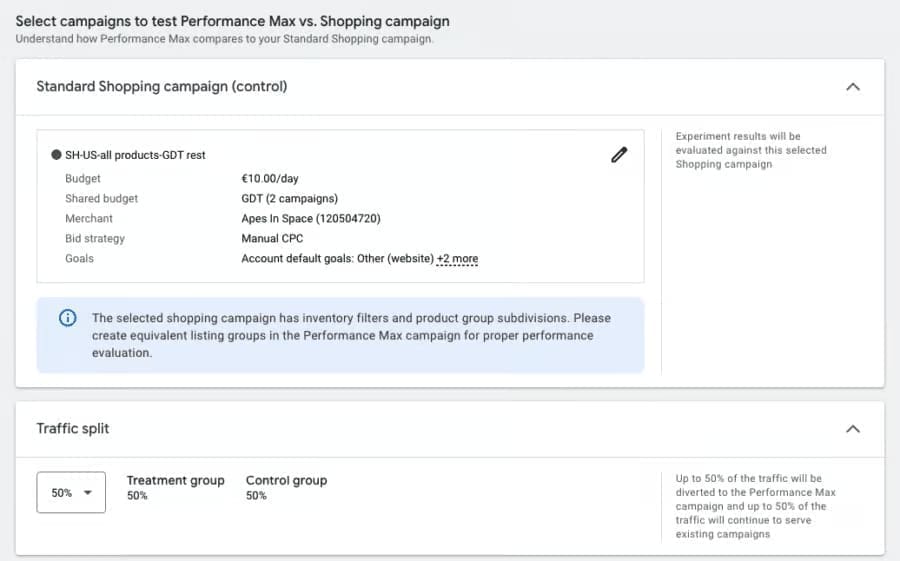
Second, you select the traffic split you want and the Performance Max campaign you want to test against:
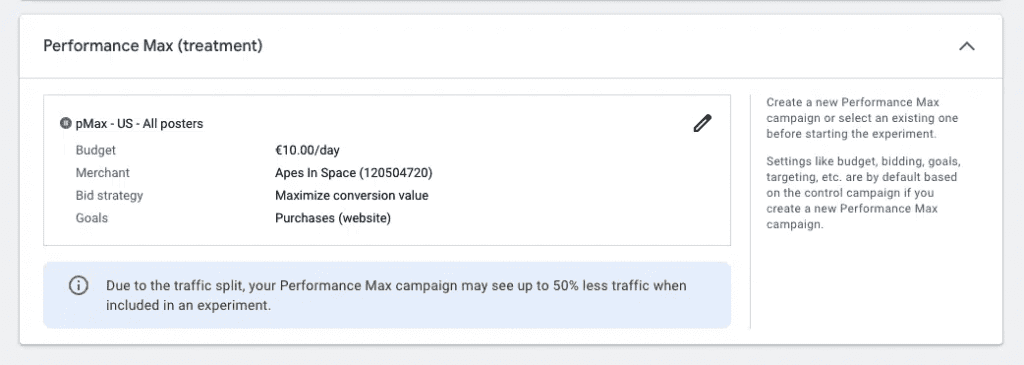
2. Demand Gen experiment
The Demand Gen experiments allow you to test 2 existing Demand Gen against one another.
This actually is a good experiment as it allows you to test a wide variety of attributes like:
Different campaign goals
Adding a bid strategy target
Ad group structure
Ads
Targeting
Impact of having multiple ads
Once you’ve figured out what you want to test, it’s time to set up the Demand Gen experiment:
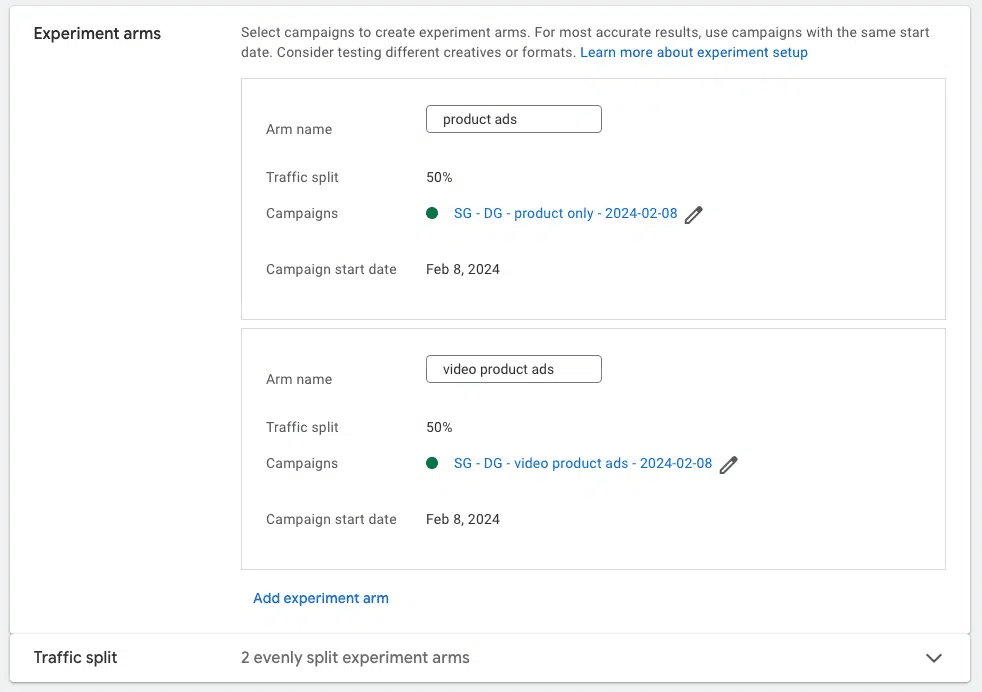
Choose your success metric:

3. Video experiment
In essence, the Google Ads video experiment involves comparing different videos within the same YouTube ads campaign to see how they perform.
To conduct a video experiment, begin by setting up 2-4 distinct experimental arms, each having identical settings but with different videos. Next, choose the success metric, either conversions or brand lift.
Google Ads will distribute the traffic equally among the campaigns and track their performance. Once at least 100 conversions are recorded, the campaign with the lowest cost per conversion will be considered the winner.

4. App Uplift experiment
The App Uplift experiment allows you to see the impact that adding more assets to your campaign has.
To learn more, you can check the Google support docs on this topic.
5. Optimise text ads
With Optimise text ads experiments, you can test variations of your Responsive Search ads.

There are three types of variations that you can create:
1) Find and replace experiment
The first ad variation you can create is to change the text you want to swap out in which part of your ad.
Here is an example of an ad variation that replaces the word “posters” with “prints” in all headlines:

2) Update URL experiment
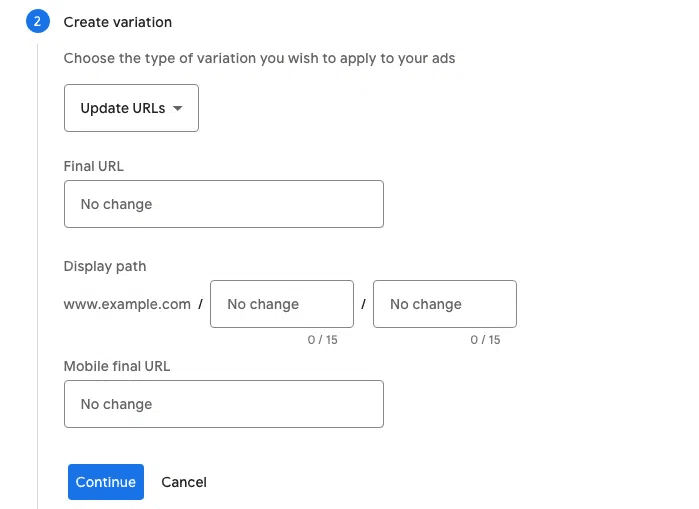
This is ideal for A/B testing different landing pages for an ad, as it allows you to split your traffic 50-50. If you created a duplicate ad with a different URL instead, that ad wouldn’t always have the same visibility as the original one.
3) Update text experiment
This allows you to Add, Remove, or Pin a certain headline or description.

6. Custom experiment
The ready-made experiments we mentioned earlier can be somewhat limited. This is where custom experiments come in handy.
A custom experiment enables you to conduct an experiment on a search or display campaign. It allows you to test other options besides those available in the three pre-made Google Ads experiments. Some potential options to test include:
Bidding strategy and bid adjustment
Keyword match types
Ad schedule
Audience targeting
Landing pages
Once you have chosen a base campaign to experiment with, you will set up the experiment and modify the settings you want to test. Google’s system will generate a new trial campaign with the updated settings.
After running the experiment and analyzing its results, you can either implement the new settings back into the base campaign or execute the experiment as a separate campaign.
What to avoid with Google Ads experiments
Along with best practices, it’s equally crucial to be aware of potential pitfalls and mistakes you can make. By understanding what to avoid when running Google Ads experiments, you can achieve meaningful results for your advertising campaigns:
1. Experimenting with things that may not be currently relevant
Google Ads experiments offer the flexibility to test various elements, but not all experiments may be relevant for optimizing campaign performance.
It’s important to avoid testing irrelevant or inconsequential elements, as it can result in wasting valuable time. Each experiment requires a waiting period of 2-4 weeks to gather data and it’s way too long to focus on things that will not bring any value.
That’s why it’s crucial to ensure that the tests conducted align with your campaign goals and have the potential to positively impact results.
For instance, if your campaign focuses on driving conversions and your campaign structure is a mess, conducting experiments that test less critical elements (e.g. testing which bidding strategy is the best) may result in wasted time without significant improvements in campaign performance.
2. Narrowing down test areas
Advertisers often make the mistake of choosing very narrow changes to test when given the opportunity to make any change.
For example, testing only one headline out of 10 in an ad, replacing only one word in the description instead of the entire description (written in a different way), or not testing your Google Shopping at all because Google Ads doesn’t offer official experiments.
When creating experiments, it’s important to test elements that have the potential to make a significant impact. Otherwise, you may end up with inconclusive results in most cases. It’s crucial to focus on changes that can truly make a difference in the overall performance.
3. Stopping experiments too soon
A common mistake is to end experiments too quickly.
Running a new experiment for only 2 or 3 days to end it and set up a new one is not the best idea. This is too short a timeframe for Google Ads to fully adapt to any changes.
It’s important to allow sufficient time to pass, including the learning period, in order to accurately assess the performance of the changes made. It’s recommended to let experiments run for at least 2 weeks to gather meaningful data and insights.
By allowing for A/B testing of various campaign settings, experiments provide insights into what works best for your audience and goals. With the ability to test changes without impacting the original campaign’s performance, advertisers can make data-driven decisions to enhance their ad performance. So, set up your Google Ads testing and unlock the full potential of your Google Ads campaigns today!
Want to brainstorm with our team on new ways to scale your business with YouTube Ads (and other performance video platforms)?
Join us for a free YouTube ad brainstorming session👇
Want more content like this?
Don’t miss out on the latest news and updates from the world of Direct Response advertising! Subscribe to our newsletter today 👇

Jovan Simic, Account Manager
Jovan Simić is an experienced media buyer responsible for over $30M in profitable ad spend. At Inceptly, Jovan has collaborated with prominent brands, including Advanced Bionutritionals, Amplify Solar, Fittrack, John Crestani, and The Social Man, demonstrating his versatility and expertise. His deep understanding of media buying and consistent track record of success make him an invaluable asset to the industry.
Like this post? Let's continue the conversation!
Get in touch with us by shooting us a quick email or tagging us on LinkedIn or Instagram, and sharing your thoughts. Your feedback helps us keep our blog relevant and interesting.
Get Our Newsletter
Need Help?
Get in touch with us for an insightful evaluation of your ads + actionable tips to help amp up your direct response revenue



